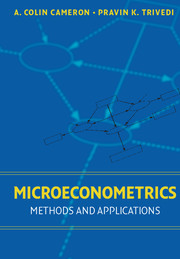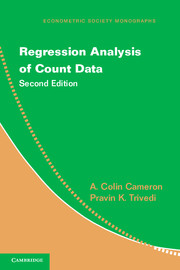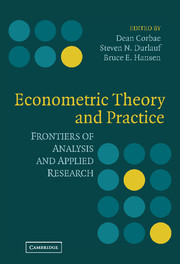Microeconometrics
This book provides the most comprehensive treatment to date of microeconometrics, the analysis of individual-level data on the economic behavior of individuals or firms using regression methods for cross section and panel data. The book is oriented to the practitioner. A basic understanding of the linear regression model with matrix algebra is assumed. The text can be used for a microeconometrics course, typically a second-year economics PhD course; for data-oriented applied microeconometrics field courses; and as a reference work for graduate students and applied researchers who wish to fill in gaps in their toolkit. Distinguishing features of the book include emphasis on nonlinear models and robust inference, simulation-based estimation, and problems of complex survey data. The book makes frequent use of numerical examples based on generated data to illustrate the key models and methods. More substantially, it systematically integrates into the text empirical illustrations based on seven large and exceptionally rich data sets.
- Most comprehensive text on microeconometrics available anywhere
- Authors are leading experts on the subject matter
- Self-contained, rich with exercises - a perennially important subject
Reviews & endorsements
"This book presents an elegant and accessible treatment of the broad range of rapidly expanding topics currently being studied by microeconometricians. Thoughtful, intuitive, and careful in laying out central concepts of sophisticated econometric methodologies, it is not only an excellent textbook for students, but also an invaluable reference text for practitioners and researchers." -Cheng Hsiao, University of Southern California
"Cameron and Trivedi have written a remarkably thorough and up-to-date treatment of microeconometric methods. This is not a superficial cookbook; the early chapters carefully lay the theoretical foundations on which the authors build their discussion of methods for discrete and limited dependent variables and for analysis of longitudinal data. A distinctive feature of the book is its attention to cutting-edge topics like semiparametric regression, bootstrap methods, simulation-based estimation, and empirical likelihood estimation. A highly valuable book." -Gary Solon, University of Michigan
Product details
September 2005Adobe eBook Reader
9780511123672
0 pages
0kg
43 b/w illus. 101 tables
This ISBN is for an eBook version which is distributed on our behalf by a third party.
Table of Contents
- 1. Introduction
- 2. Causal and non-causal models
- 3. Microeconomic data structures
- 4. Linear models
- 5. ML and NLS estimation
- 6. GMM and systems estimation
- 7. Hypothesis tests
- 8. Specification tests and model selection
- 9. Semiparametric methods
- 10. Numerical optimization
- 11. Bootstrap methods
- 12. Simulation-based methods
- 13. Bayesian methods
- 14. Binary outcome models
- 15. Multinomial models
- 16. Tobit and selection models
- 17. Transition data: survival analysis
- 18. Mixture models and unobserved heterogeneity
- 19. Models of multiple hazards
- 20. Models of count data
- 21. Linear panel models: basics
- 22. Linear panel models: extensions
- 23. Nonlinear panel models
- 24. Stratified and clustered samples
- 25. Treatment evaluation
- 26. Measurement error models
- 27. Missing data and imputation
- A. Asymptotic theory
- B. Making pseudo-random draw.







